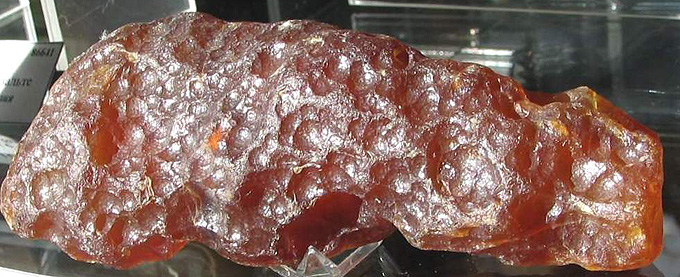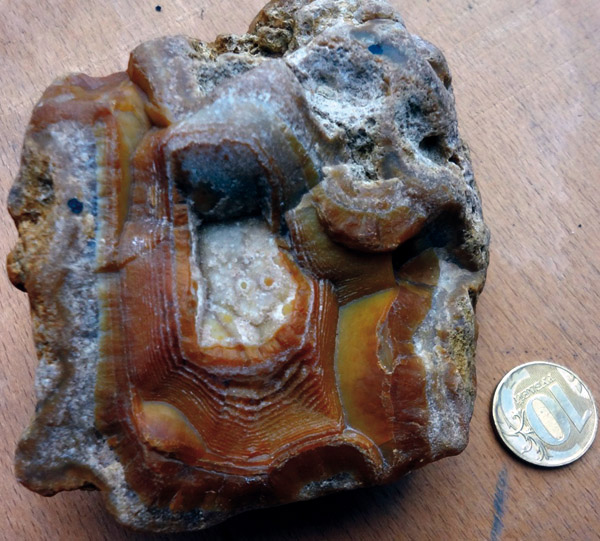Carnelian, Carnel



 Characteristics of the mineral.
Characteristics of the mineral.
Orange-red variety of chalcedony. Chalcedony is a grayish translucent silicon oxide with a cryptocrystalline structure (consisting of the finest fibers that can be distinguished only under a microscope). Coloring from yellow, orange to red and dark red it gives iron, green color attached to chlorides. Depending on the color saturation, Carnelian has several more names. The most saturated with a red tone, clean and relatively transparent, resembling a cloudy blood-drop, is called carneol - one of the best carnelians. Sarders usually call yellow chalcedony, carnelian - orange medium saturation. Sardonyx - carnelian with straight parallel layers of intermittent brown, white and bluish-gray colors (orange variety of agate).
Carnelian - the word Russian, which means pleasing (or reminiscent) heart. Carnelian of yellow color is called linkurium. It is difficult to draw a clear boundary between carnelian and sarder, since there is a gradual transition between them. The coloration of red chalcedony can be explained by the presence of brown gels of iron hydroxides, and in the dark-brown parts of it is three to four times greater than in the light ones. Carnelian - a stone of blood color, the color of life, in this regard, the ancient peoples of the East believed that it has the property to protect the living from death and disease, to give happiness and peace. At the same time it was believed that he could promote the emergence of love, and it was worn as a talisman.
In Russia, this stone was known for a long time. Its ancient Russian name is "smazen" or "kadnos". In the Middle Ages, the carnelian was divided into masculine - red-brown and female - pink-orange. In the medieval "Azbukovnik" it was said that "cornelian is red blood yak, transparent." He "with his reddish color resembles fire and blood, depicts the flame of faith." This beautiful stone can really improve the mood, because they can admire without end. And today carnelian is no less popular in our country than it was thousands of years ago. Currently, carnelian jewelry is made - inserts cut in the form of a cabochon, rings and rings, beads and bracelets.
There is a misconception that carnelian allegedly differs increased radioactivity, and therefore has a stimulating effect on organic cells. Measurements of radiation show the falsity of this assumption. Exact investigations have established that the radioactivity of this stone does not exceed the radioactivity of therapeutic muds and some mineral waters.
Magic properties of stones.
Carnelian - chalcedony from yellow to orange, red and brown, translucent and pure, it is the strongest talisman of love, it also removes the influence of evil people and essences, brings success in business and attracts well-being, distracting the host of enemies and ill-wishers. He reveals the natural gifts of man, helps to find his path and vocation, especially if the owner is inclined to art: painting, music, theater, etc. Dark red carnelians (dark orange carnelians and especially carnelians) stimulate the sexual energy of man and his Sexual attraction for the opposite sex. Carnelian of any color is not a love-stone (unlike quartz-hairy), it is a stone for purely personal use.
"Male" carnelian - dark reddish and brown tones, "female" - a delicate yellow or orange-pink, like a ripe peach. It has a calming and restraining effect. It is the stone of the Sun, absorbed in its energy and hot radiant color. Stabilizes and strengthens the "qi", it is recommended as a talisman to the Twins. It gives love, conjugal happiness, health and courage, helps to keep calm in a dispute, stops a person when he starts to use his powers unreasonably. Protects against the machinations of enemies. Carnelian should be worn in a bracelet to wrestlers. Carnelian heals the wounds of the soul. The head of a serpent snake is a talisman to protect its owner in the other world from reptiles. A cornelian heart with the image of a phoenix bird with a solar disk on its back is a symbol of resurrection.







Agate cornelian. Sinarsky deposit, Ural, Zauralye, Kurgan region, Russia (RF, CIS). Photo: © A. Evseev.

Agate cornelian. Agate. "Molzhiv," the state farm, Magnitogorsk (rn), Yu Ural, Russia (RF, CIS). Photo: © A. Evseev.
Poisonous and radioactive dangerous stones and minerals
** - poisonous stones and minerals (mandatory check in the chemical laboratory + explicit indication of toxicity).
** - radioactive stones and minerals (mandatory check on the standard dosimeter + ban on open sales in the case of radioactivity over 24 milli / g / h + additional measures of population protection).
All rare stones are subject to mandatory inspection at the standard dosimeter for the permissible level of radiation and in the chemical laboratory for the absence of poisonous and evaporating components that are dangerous to humans and the environment.


Comments
When commenting on, remember that the content and tone of your message can hurt the feelings of real people, show respect and tolerance to your interlocutors even if you do not share their opinion, your behavior in the conditions of freedom of expression and anonymity provided by the Internet, changes Not only virtual, but also the real world. All comments are hidden from the index, spam is controlled.